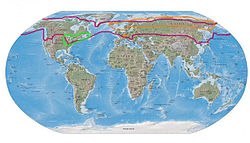Cranberry
A cranberry is a fruit. It grows on an evergreen dwarf shrub. Cranberries are in the genus Vaccinium, and its subgenus Oxycoccus. In some classification methods, they are regarded as a genus in their own right.
Cranberry plants grow in acidic bogs in cooler areas of the northern hemisphere. They are low creeping shrubs up to seven feet (3 m) long, from two to eight inches (5-20 cm) high. They have slender and wiry stems with small leaves which are evergreen with dark pink flowers. Cranberries are usually eaten during Thanksgiving in the United States. They are also eaten in Europe and some parts of South America.
Cranberries are strong cash crops for certain U.S. states. They are turned into juice, sauce or jam. Since 2000, cranberries have been marketed as superfruit due to their antioxidant and nutrient qualities.
Cranberry Media
Cranberries (Vaccinium microcarpus) ripen in a muskeg near Petesburg, AK. Muskegs, a colloquial term for peat bogs, blanket 10% of the Tongass National Forest. These wetlands range in size from a few square feet to many acres. Over the ages, muskegs formed as Sphagnum mosses, rushes and sedges grew and built up spongy carpets in these very wet, almost treeless areas. Photo by Karen Dillman.
The Cranberry Harvest on the Island of Nantucket, Eastman Johnson, 1880.










